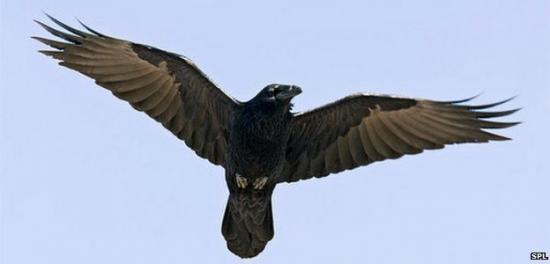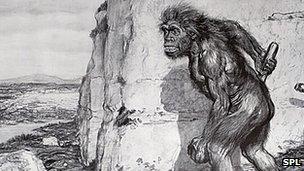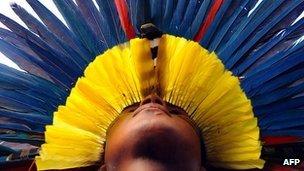Paul Rincon
Source - http://www.bbc.co.uk/news/science-environment-19623929

Ravens are among the birds whose remains are found at Neanderthal sites
Our evolutionary cousins the Neanderthals were harvesting feathers from birds in order to use them as personal ornaments, a study suggests.
The authors say the result provides yet more evidence that Neanderthal thinking ability was similar to our own.
The analysis even suggests they had a preference for dark feathers, which they selected from birds of prey and corvids - such as ravens and rooks.
Details of the research appear in Plos One journal.

Our views of Neanderthals have come a long way since this representation was painted in 1909
Numerous tribal peoples from history have also adorned themselves with feathers, and the authors stress that they are not suggesting we learned the practice from Neanderthals.
Feather ornamentation could in fact go back even further, to a common ancestor of modern humans and Neanderthals.
Clive Finlayson and Kimberly Brown from the Gibraltar Museum, along with colleagues from Spain, Canada and Belgium, examined a database of 1,699 ancient sites across Eurasia, comparing data on birds at locations used by humans with those that were not.
They found a clear association between raptor and corvid remains and sites that had been occupied by humans.
They then looked more closely at bird bones found at Neanderthal sites in Gibraltar, including Gorham's and Vanguard cave, near the base of the rock: "The Neanderthals had cut through and marked the bones. But what were they cutting? We realised a lot of it was wing bones, particularly those holding large primary feathers," Prof Finlayson told BBC News.
Co-author Jordi Rosell, from Rovira i Virgili University in Tarragona, Spain, said: "We saw the cut-marks on bird bones at one cave, and then started seeing them in others. I think it's a common aspect to the caves in this rock."
Juan Jose Negro, director of the Donana Biological Station in Seville, Spain, who is another co-author, said: "The wings make up less than 20% of the weight of the body of those birds," adding, "there is no meat in the wings - they were not consuming these animals.
"The only explanation left is the use of those long feathers."
Not only this, but the ancient humans appeared to have a preference for birds with dark or black plumage. Species represented at the sites include ravens, crows, rooks, magpies, jackdaws, various types of eagle and vulture, red and black kites, kestrels and falcons.
Image correction
Speaking to me at this year's Calpe conference in Gibraltar, Prof Finlayson explained: "What all this suggests to us is that Neanderthals had the cognitive abilities to think in symbolic terms. The feathers were almost certainly being used for ornamental purposes, and this is a quite unbelievable thing to find."

Historic peoples have also used feathers to signal status and power
For much of the last century, Neanderthals were portrayed as knuckle-dragging brutes, whose extinction some 30,000 years ago was the natural outcome of competing against a more intelligent, creative and resourceful human species - Homo sapiens.
In recent years, the Neanderthals - who lived across Europe, the Middle East and Central Asia in Pleistocene times - have come to be rehabilitated amid mounting evidence that their abilities had been underestimated.
"I think this is the tip of the iceberg," said Prof Finlayson: "It is showing that Neanderthals simply expressed themselves in media other than cave walls. The last bastion of defence in favour of our superiority was cognition."
Neanderthals, he said, may have been "different", but "their processes of thinking were obviously very similar".
Dr Negro cautioned that there was no way to tell how the feathers were put to use. But he observed: "Current uses of feathers typically involve the same species. If you think of the Plains Indians in North America, they put those feathers in headdresses and they are signalling. They are signalling power and status. Perhaps the Neanderthals were using feathers in the same way."
Asked how the ancient humans might have caught the birds, Clive Finlayson speculated: "It's possible that these birds were nesting near the caves. Some may have fallen, but there's too much of it to be a random collection of dead animals.
"It's possible the Neanderthals were climbing up the cliffs and collecting birds from nests. But a large proportion of these birds are scavengers.
"An intelligent hominid, aware of this - and who may have used vultures as an indication of food sources - could easily have found ways of ambushing vultures and eagles when they came down to carcasses."
Other evidence of symbolic behaviour in Neanderthals includes the discovery of ochre - used to paint their bodies - at archaeological sites in Europe and the Levant. Earlier this year, another team published evidence of the possible symbolic use of eagle claws by Neanderthals, although they might also have been using the items as tools.